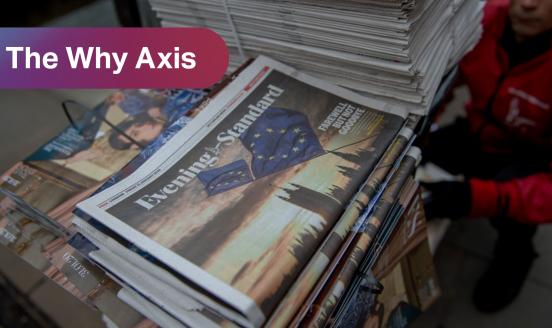Trumpocalypse now: first reactions
What’s at stake: this question should probably be re-formulated as “what’s NOT at stake?” On Tuesday 8 November, the US elected Donald Trump as its ne
Making sense of it
If you are like me, you are still probably asking yourself how did this happen. Electoral post-mortems are painful but needed. So if you still cannot make sense of it, Sylvain Chabé-Ferret has a good summary of currently prevailing theories on the roots of populism.
One view is that this is a sign that the losers of globalisation are striking back. White blue-collar workers that have been hit by globalisation are voting for more protection from foreign workers. The fact that the middle class in developed countries has seen stagnating incomes since late 1980s has made its radicalisation more easy (see work by Branko Milanovic, Mishel et al. and Autor et al. on these aspects). Also look at Jed Kolko’s piece over at FiveThirtyEight, on Trump being stronger where the economy is weaker.
Another view sees this as a rebellion by the losers from technological change: a huge change in advanced economies has been the progressive disappearance of mid-level routine jobs. This is causing a polarisation of the job market, where mid-level industrial and clerical jobs are replaced by robots and computers, leaving unskilled and high-skilled workers in almost different worlds (see e.g. Autor or McAfee and Brynjolfsson).
Others explain the result by arguing that a white majority feels threatened by the rise of the ethnic minorities. The underlying idea is that the modern welfare state is easier to maintain when there is ethnic homogeneity and that the increase in the size of the Hispanic and African-American communities might have triggered a fear reaction from the white majority that is now trying to protect itself by restricting access to citizenship or even deporting immigrants (see e.g. Kauffman and Cavaillé).
Others, like Simon Wren-Lewis argues this is about ideology - as we live in a time when parties are weak and partisanship is strong - and the media (particularly Fox news). Without accounting for the role of the media, Lewis argues, it would not be possible to explain entirely (i) why partisanship appears to be much stronger in the Republican party and (ii) why Republicans have become so extreme.
Moving forward
You are now ready for the next question: what is going to happen now?
For a quick look at what economists expect, The Wall Street Journal published their monthly survey of economists, conducted after the election and including expectations for 2017/18.
Let’s start with Tyler Cowen, who wonders which macroeconomic theories will rise and fall in status because of Donald Trump. Here’s a list, for your future reference. (1): “The multiplier is high” is likely to decline in status; (2): “We need to do stimulus right” will make a comeback, possibly together with “the distributional effects of stimulus really matter”; (3) “Tax cuts aren’t as good as government spending” may actually rise in status, especially if Congress gets the bargain they want (lots of tax cuts) rather than what Trump wants; (4): don’t expect the notion of how a credibly irresponsible leader can improve macro performance to get cited as much; (5): Austrian-like theories of how there can be a boom in the short run, yet with great long-run dangers, will return to prominence; (6): criticising countries with trade surpluses will decline in status; and (7): the efficient markets hypothesis will decline in status, as it imposes too much discipline on our judgments of leaders and their policies.
Olivier Blanchard at PIIE points out that electoral programs are never implemented as such. It is safe to assume that only those measures not too inconsistent with the views of Paul Ryan, Mitch McConnell, and their constituencies will see the light of day. Under this assumption, what happens to the US economy depends mainly on the balance between macroeconomic and trade measures. On the macroeconomic front, signs point to larger fiscal deficits, as a result of both higher infrastructure spending and corporate and personal tax cuts. If deficits take place, they will lead to higher spending and higher growth for some time. And with the US economy already operating close to potential, deficits will lead to higher inflation, potentially leading the US Federal Reserve to react by increasing rates faster than it intended to before the election.
To the extent that both growth and interest rates are higher, the dollar is likely to appreciate, leading to larger US trade deficits, which Trump indicated he wanted to fight. A major part of Trump’s pre-election program emphasised the use of tariffs. Imposing tariffs on a major scale would decrease growth and make a recession more likely. Blanchard thinks that the Trump administration will go slowly on that front, starting with mainly symbolic measures as a sign of a longer commitment. But things could quickly escalate: as fiscal deficits lead to larger trade deficits, the pressure to reduce them through more tariffs, as misdirected as that strategy is, will likely increase. So, in the end, expansion or recession will depend on the balance between macroeconomic and trade measures. Blanchard’s guess is that the first will dominate, and growth will be sustained, at least for some time. Whether this will be enough to satisfy those who voted for Donald Trump is still unclear.
Larry Summers warns that a badly-designed US stimulus will only hurt the working class. Trump’s infrastructure investment plans suggest an approach based on tax credits for equity investment and total private sector participation that will not cover the most important projects, not reach many of the most important investors, and involve substantial mis-targeting of public resources. Many of the highest-return infrastructure investments do not generate a commercial return and so are excluded from his plan. Nor can the non-taxable pension funds, endowments and sovereign wealth funds that are the most promising sources of capital for infrastructure take advantage of the program. Trump’s tax reform proposals are too expensive and many, like the proposed abolition of the estate tax, will only benefit the high-saving wealthy. Moreover, Trump’s global plan rests on a misunderstanding of how the world economy operates. Summers concludes that everyone with a stake in the global economy must hope for a major adjustment to the campaign's economic plans.
Paul Krugman thinks that installing Donald Trump in the White House is an epic mistake. Itcould have apocalyptic consequences, but probably not in the short run. There is always a disconnect between what is good for society, or even the economy, in the long run, and what is good for economic performance over the next few quarters. Moreover, the specifics of the US economic situation mean that for a time, at least, a Trump administration might actually end up doing the right thing for the wrong reasons (an accidental, badly designed stimulus would still, in the short run, be better than no stimulus at all).
In the longer run, Krugman thinks Trumpism will be a very bad thing for the economy in a couple of ways. For one thing, we’re about to see a major degradation in both the quality and the independence of public servants. If we face a new economic crisis, perhaps as a result of the dismantling of financial reform, it’s hard to think of people less prepared to deal with it. Moreover, Trumpist policies will hurt, rather than help, the American working class: eventually, promises to bring back the good old days will be revealed as the cruel joke they are. But the consequences of the new regime’s awfulness won’t be apparent right away: opponents need to be prepared for the real possibility that good things will happen to bad people, for a while.
Joachim Fels on Pimco’s blog says that markets seem to be in a “Dr. Strangelove” mood Before embracing the bomb, there would be five things to consider. First, both right-tail and left-tail risks for the global economy and markets will likely become fatter under President Trump. Second, while a US recession over the next year or two may now look less likely, the risk that the current expansion ends in tears in 2019 or 2020 has increased. Third, central bank independence as we know it is likely to come under further attack, given both the long-standing criticism of the Fed in conservative Republican circles and the President-elect’s attacks on the Yellen Fed. Fourth, in the face of the sharp sell-off in bond markets, the Bank of Japan’s new strategy of “yield curve control” looks even smarter now and might become a blueprint for other central banks, potentially including the Federal Reserve. Fifth, the market reaction to Donald Trump’s election provides a serious test case for the “Shanghai co-op,” as Fels calls an informal understanding by the world’s major central banks that excessive dollar strength is bad for everyone and should be avoided.
Richard Turnill on BlackRock Blog sees the election results as “fuel for the reflationary fire”. The result is increasing the likelihood of income and corporate tax cuts, as well as greater spending on infrastructure in the medium term. These measures could create jobs and support wage growth, further fueling today’s reflationary trend and increasing the fiscal deficit. This should result in at least a moderately steeper US Treasury yield curve, and possibly lead the Fed to raise rates next month with a rising chance of additional future rate hikes. There are, however, increased long-term economic and market risks. The Trump shock has magnified political uncertainty linked to rising populist pressures ahead of key votes in Europe. The President-elect has vowed to overturn or re-negotiate trade deals. This could hurt the global economy - particularly export-dependent emerging markets - and spark risk-off sentiment and a weaker Chinese yuan. These jitters were reflected in rising volatility and a selloff in emerging-market assets after the election.
Duncan Weldon argues that we can think of the political economy of Trump through the lens of trilemmas and ultimately inflation. One is the well-known globalisation trilemma by Dani Rodrik. Trump is talking about unilaterally asserting US policy freedom: read on Rodrik’s trilemma, an “America First” approach implies dumping deep economic integration in favour of the nation state and democratic policies. But the populist attempts to “take back control” could counter-intuitively leave policy-makers with less control. In macroeconomic terms, a large part of the Trump agenda will be inflationary and lowering the ability to import disinflation from the rest of the globe could worsen the trade-offs involved in any particular fiscal/monetary policy mix. The second trilemma is Deutsche Bank’s 2015 “new impossibility trinity”, stating that only two of high corporate profits, decent nominal wage growth and steady inflation are possible as long as productivity growth remains exceptionally weak. So assuming productivity growth remains weak, and President Trump does not favour a collapse in corporate profits, the result is higher inflation.
Weldon argues that a policy mix (fiscal/monetary/economic openness) that delivers decent nominal wage growth, stronger growth and higher nominal rates would suit Trump as President. The Fed though is likely to be far less keen. Trump’s choices on the globalisation trilemma make his choices on the impossibility trilemma more acute and potentially lay the groundwork for a battle between the administration and the Federal Reserve over economic policy. That could be one of the crucial fights to watch in the next four years.



